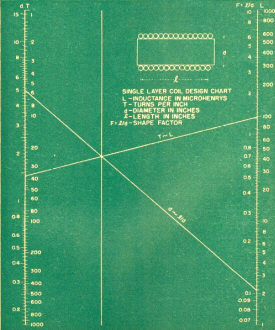Single Layer Coil Design Chart
|
|
Single layer coil design charts (aka nomographs) are a dime a dozen on the Internet. This nomograph appeared in a 1955 issue of Popular Electronics magazine. A couple examples of usage are included. The textbook Wheeler's formula for a single-layer coil with closely wrapped turns (wire diameter << coil diameter) is L = μr * d2 * N2 / (18 * d + 40 * l), where l has units of inches and L has units of μH. To verify one of the examples given in the article: L = μr * d2 * N2 / (18 * d + 40 * l), = 1 * 52 * 192 / (18 * 5 + 40 * 0.52) = 81.45 μH, which is significantly less than the 100 μH given in the article. Another, more extensive Wheeler inductance formula (too long to reproduce here) yields 90.9 μH. Maybe I made a mistake somewhere, but I don't think so. I also downloaded the Coil64 software and plugged numbers into it and go similar results. I'm not saying the chart is wrong, just verify the results before relying on it. These are without regard to frequency. Single Layer Coil Design Chart
EXAMPLE A: We have a coil 5" in diameter, 19 turns, 37 turns per inch, and wish to find the inductance. l = 19/37" = .52"; l/d = .52/5 = .104. Draw a line between d=5 and l/d = .104. Draw a second line from T = 37 through the intersection point to the L scale. Read the answer, 100 microhenries. EXAMPLE B: We require the number of turns of a coil 5" in diameter, wound 37 turns per inch, to give 100 microhenries. Draw a line between T = 37 and L = 100. Draw a second line from d = 5, through the intersection point, to the l/d scale, and read l/d = .104. Then l = 5 x .104 = .52 Inches. The number of turns is .52 x 37 = 19, approximately. Single Layer Coil Design Chart
Posted January 12, 2023 |
|

